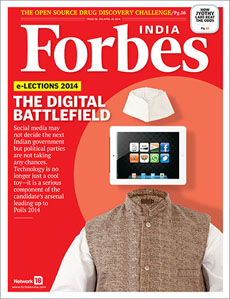
The Digital Vote Bazaar
Winning margins are often less than 5 percent. It is this last 5 percent that social media can possibly deliver in as many as 160 Lok Sabha constituencies
Few spectacles in the world can rival the colour and vibrancy of an Indian general election. With 814 million registered voters, a diverse population differentiated by caste, community, ethnicity and language, among other things, India offers one of the greatest bazaars for hawking electoral wares, ideas and options. Little wonder, this bazaar is as much about commerce and business as it is about electoral promise and performance.

Thanks to the advent of social media and ubiquitous mobile telephones, a new type of digital business is developing around helping candidates and political parties touch base with potential voters virtually. In India, while the mobile phone population exceeds the voter base, social media users are said to be around 103 million—clearly not enough to impact electoral outcomes significantly this time. However, given the nature of the electoral battle—where there are three- and four-horse races in almost every state, India’s first-past-the-post system enables winners to romp home with just about 30-35 percent of the popular vote. Or even less. And winning margins are often less than 5 percent. It is this last 5 percent that social media can possibly deliver in as many as 160 Lok Sabha constituencies.
To make things more interesting, some of India’s most popular politicians have taken to social media, with Narendra Modi of the BJP having 11.8 million Facebook fans and Arvind Kejriwal 4.8 million. They also have large Twitter followings. While the former is a potential prime minister, the latter has struck a chord with the urban voter with his anti-corruption message—a message delivered largely through social media. The other major parties, though late to the party, are also clambering onto the social media bandwagon, and the Congress party now has 2.26 million FB fans, within shouting distance of the BJP’s 3.18 million. On Facebook as outside it, Modi is obviously more popular than his party.
How all this digital chatter and outreach will impact actual voting patterns remains to be seen, for you still have to step out and reach the polling booth, but one thing is clear: Its importance can only grow as social media penetration skyrockets, and electoral engagement through traditional means gets costlier. This offers a huge business opportunity for scores of digitally-savvy entrepreneurs, as this issue’s cover story documents. There will be many more of them springing up in future elections.
Best,
R Jagannathan
Editor-in-Chief, Forbes India
Email: r.jagannathan@network18online.com
Twitter id: @TheJaggi
(This story appears in the 18 April, 2014 issue of Forbes India. To visit our Archives, click here.)
Post Your Comment














